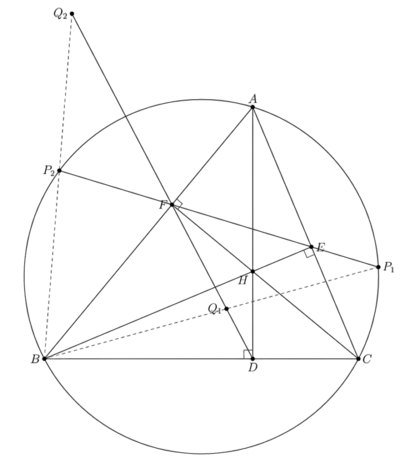Difference between revisions of "2010 IMO Shortlist Problems/G1"
(→Solution) |
(Formatting) |
||
| Line 1: | Line 1: | ||
== Problem == | == Problem == | ||
| + | |||
(United Kingdom) Let <math>ABC</math> be an acute triangle with <math>D</math>, <math>E</math>, <math>F</math> the feet of the altitudes lying on <math>BC</math>, <math>CA</math>, <math>AB</math> respectively. One of the intersection points of the line <math>EF</math> and the circumcircle is <math>P</math>. The lines <math>BP</math> and <math>DF</math> meet at point <math>Q</math>. Prove that <math>AP = AQ</math>. | (United Kingdom) Let <math>ABC</math> be an acute triangle with <math>D</math>, <math>E</math>, <math>F</math> the feet of the altitudes lying on <math>BC</math>, <math>CA</math>, <math>AB</math> respectively. One of the intersection points of the line <math>EF</math> and the circumcircle is <math>P</math>. The lines <math>BP</math> and <math>DF</math> meet at point <math>Q</math>. Prove that <math>AP = AQ</math>. | ||
| − | == Solution == | + | == Solution 1 == |
| + | |||
[[File:2010_IMO_Shortlist_G1.png|400px|thumb|right]] | [[File:2010_IMO_Shortlist_G1.png|400px|thumb|right]] | ||
Let <math> \measuredangle</math> denote [[directed angles]] modulo <math>180^{\circ}</math>. | Let <math> \measuredangle</math> denote [[directed angles]] modulo <math>180^{\circ}</math>. | ||
| Line 19: | Line 21: | ||
(Note that with directed angles in place, both the two possible configurations (shown in graph) are solved.) | (Note that with directed angles in place, both the two possible configurations (shown in graph) are solved.) | ||
| − | + | == See Also == | |
| − | |||
| − | == | ||
* [[2010 IMO Shortlist Problems]] | * [[2010 IMO Shortlist Problems]] | ||
| − | * [ | + | * [//artofproblemsolving.com/community/c6h418633p2361970 Discussion on AoPS] |
| − | |||
| − | |||
[[Category:Olympiad Geometry Problems]] | [[Category:Olympiad Geometry Problems]] | ||
Latest revision as of 16:36, 18 February 2025
Problem
(United Kingdom) Let ![]() be an acute triangle with
be an acute triangle with ![]() ,
, ![]() ,
, ![]() the feet of the altitudes lying on
the feet of the altitudes lying on ![]() ,
, ![]() ,
, ![]() respectively. One of the intersection points of the line
respectively. One of the intersection points of the line ![]() and the circumcircle is
and the circumcircle is ![]() . The lines
. The lines ![]() and
and ![]() meet at point
meet at point ![]() . Prove that
. Prove that ![]() .
.
Solution 1
Let ![]() denote directed angles modulo
denote directed angles modulo ![]() .
As
.
As ![]() ,
, ![]() is cyclic.
is cyclic.
As ![]() and
and ![]() are both cyclic,
are both cyclic,
![]() .
.
Therefore, we see ![]() is cyclic. Then
is cyclic. Then
![]() .
.
We deduce that ![]() , which is enough to apply that
, which is enough to apply that ![]() is isosceles with
is isosceles with ![]() .
.
(Note that with directed angles in place, both the two possible configurations (shown in graph) are solved.)










